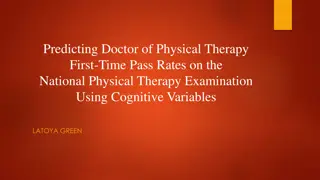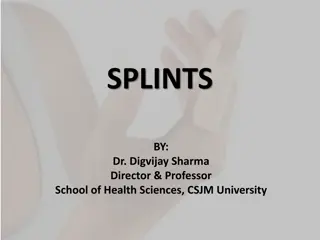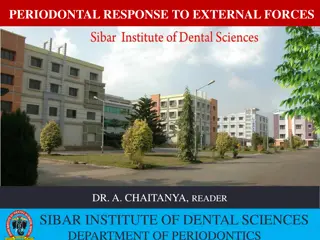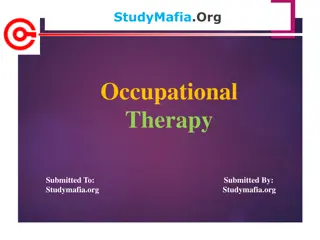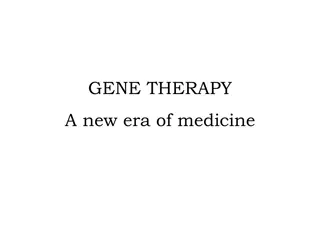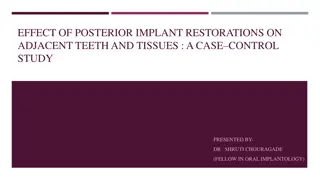Understanding Occlusal Evaluation, Therapy, and Splints
Occlusal evaluation, therapy, and splints play a crucial role in assessing and treating occlusal function and dysfunction. The relationship of occlusion to periodontal health, forces during jaw movements, and the biologic basis of occlusal function are discussed. The importance of balancing occlusion to minimize stress and prevent periodontal tissue injuries is highlighted. Various clinical aspects, including parafunctional habits and occlusal forces, are examined to provide a comprehensive understanding of occlusal management.
Download Presentation

Please find below an Image/Link to download the presentation.
The content on the website is provided AS IS for your information and personal use only. It may not be sold, licensed, or shared on other websites without obtaining consent from the author. Download presentation by click this link. If you encounter any issues during the download, it is possible that the publisher has removed the file from their server.
E N D
Presentation Transcript
OCCLUSAL EVALUATION THERAPY AND SPLINTS PRESENTED BY PRIYANJALI JADHAV
CONTENTS: Introduction Forces during jaw movements Biologic basis of occlusal function Occlusal function and dysfunction Parafunction Clinical Examination Occlusal Therapy Clinical studies
INTRODUCTION: Occlusion is the static relationship between the incising or occlusal surfaces of maxillary or mandibular teeth or tooth analogues. The occlusion should be balanced as stress free as possible Among the numerous local and systemic factors with the potential to influence the progression of periodontitis ,the patients occlusion remains a variable that requires an exact diagnosis
Occlusion becomes a factor for consideration when the occlusal forces acting on a tooth produce displacement of the root in the socket which results in an injury to the supporting periodontal ligament This periodontal tissue injury from occlusal forces has been defined as the the lesion of trauma from occlusion
FORCES DURING JAW MOVEMENTS: The teeth and their periodontium are subjected to functional dynamic loading during chewing,swallowing and the performance of parafunctional habits,including bruxism and clenching Tooth contact is minimal during speech ( Gibbs CH 1972)
The forces generated by these contacts are of relatively low magnitude ,averaging 81 N and short acting with a duration of about 20-50 ms Harmonious occlusal force on a tooth simulates the physiologic arrangement of its periodontal attachment fibers and its osseous architecture and encourages its stability Forces that exceed the tolerance of the periodontium result in resorption of the bone and disruption of the attachment
BIOLOGIC BASIS OF OCCLUSAL FUNCTION A Physiologic occlusion is present when no signs of dysfunction or disease are present and no treatment is indicated A Nonphysiologic occlusion is associated with dysfunction or disease caused by tissue injury and treatment may be indicated . A Therapeutic occlusion is the result of specific interventions designed to treat dysfunction or disease
Maintenance of a physiologic occlusion require favourable structure function relationships and optimal tissue adaptation throughout the masticatory system When occlusal forces are distributed optimally the occlusion will be stable by objective criteria and is likely to be subjectively comfortable for the patient
OCCLUSAL FUNCTION AND DYSFUNCTION The identification of masticatory system disharmonies allows the clinician to recognize dysfunctional relationships which may influence the accuracy of the diagnosis Stability is enhanced by the simultaneous bilateral contact of multiple posterior teeth with occlusal forces in the long axis of ost posterior teeth.
PARAFUNCTION BRUXISM- An oral habit consisting of involuntary rhythmic or spasmodic non functional gnashing, grinding or clenching of teeth , in other than chewing movements of the mandible , which may lead to occlusal trauma Common cause for attritional wear , loose teeth , fractured cusp and muscle pain
In the case of a sustained low level force the amount of deformation of the periodontal membrane increase with the passage of time,due to viscous drag and capillary vessels in the periodontal membrane is compressed causing ischmia. Repetition of this ishemic condition may affect the resistance of the periodontal tissue.
BRUXISM AND PERIODONTAL DISEASE Bruxism does not initiate gingivitis or pocket formation The most frequent results of bruxism are compensatory hypertrophy of the periodontal structures and increase in width of the periodontal membrane
When there is pre-existing gingival inflammation and particuraly when there is some loss of tooth support the weight of evidence suggests the bruxism probably accelerates the destructive process as does any other form of secondary occlusal trauma
CLINICAL EXAMINATION A comprehensive evaluation of masticatory system and muscles and occlusal anatomy is pre requisite to identify any occlusal disharmony Clinical assements to be done are- TMJ evaluation Testing for mobility of teeth Centric relation assessment Evaluation of excurions Articulated diagnostic casts
OCCLUSAL THERAPY The purpose of occlusal therapy is to establish stable functional relationship favourable to the oral health of the patient including periodontium effective nonsurgical therapy usually reduces inflammation within the periodontium and results in some healing of attachment which often results in mobile teeth becoming more stable
REQUIREMENT FOR OCCLUSAL STABILITY Maximum intercuspation Smooth excursive movements without interferences Light or absent anterior contacts No trauma from occusion Well distributed posterior contacts Favorable subjective response to occlusal form and function Cross tooth stablilization
TREATMENT OPTIONS: When there is sufficient evidence of excessive occlusal forces on the patients teeth or when masticatory system disharmony exists and the patients desires a more stable occlusion, then an occlusal appliance is prescribed- Treatments options are- 1. Occlusal appliance therapy 2. Occlusal adjustment 3. Occlusal stability for restorative dentistry 4. Orthodontic tooth movement 5. Orthognathic therapy
OCCLUSAL ADJUSTMENT Occlusal adjustment or the selective reshaping of the occluding surfaces of the teeh can reduce the magnitude of occlusal interferences or direct the forces to be more compatible with the long axes of the effected teeth Accurately mounted duplicate models can be used to accomplish a trial occlusal adjustment to determine safety and efficacy for patient
The clinical goal of intercuspal position and returded contact position adjustment are to reduce the supracontacts as as to create unobstructed closure of cusps into fossae and argina ridges The correction of occlusal supracontacts consisting of grooving,spheroiding and pointing.
TYPES OF SPLINTS PERMISSIVE OCCLUSAL SPLINT Have a smooth surface on one side that allow the musles to move the mandible without interference from deflective tooth inclines so the condyles can slide back and up to complete seating in to the centric realtion DIRECTIVE OCCLUSAL SPLINT Direct the lower arch into a specific occlusal relationship that in turn directs the condyles to a predetermined position






